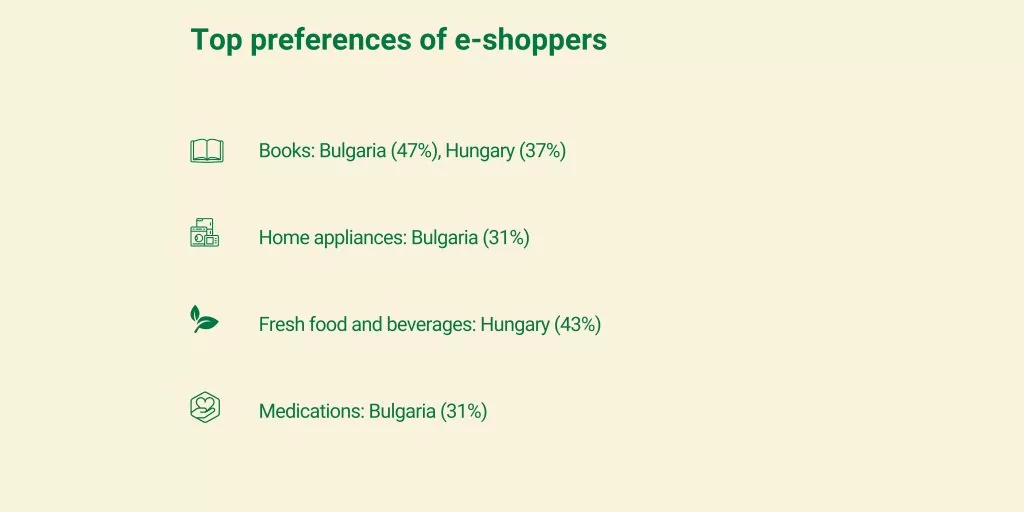Online shoppers in these CEE countries tend to make purchases from foreign online stores. Hungarians (77%) are the most active in this sense, followed by Bulgarians (71%) and Romanians (67%). Considering that the EU average for shopping from foreign websites is 57%, these percentages are quite high. The primary reason for this is that consumers try to find better prices and product selections than those available locally.
The top preferences of e-shoppers in these CEE countries include books Bulgaria (47%), Hungary (37%); home appliances Bulgaria (31%); fresh food and beverages Hungary (43%); and medications in Bulgaria (31%).

Hungary
Hungary is the 57th largest growing ecommerce market. Its CAGR is projected to grow by 12% (2023-2027). Even though most Hungarians still prefer COD, cashless payments are increasing and retailers who want to expand in this market should focus on offering such solutions. The most popular online purchases among Hungarians are books, coupons, IT and electronics, insurance services, e-tickets, and holiday bookings.
- In the eCommerce market, the number of users is expected to amount to 5.8m users by 2027. (Statista)
- Almost 40% of ecommerce revenue is generated in the last two months of the year before the holiday season.
- Footwear is the flagship product in Hungary (53%)
Popular delivery methods
Courier 80%
Pickup Points 38%
regular postal delivery 36%
Lockers 27%
Fashion market growing
With users increasing and more brick-and-mortar stores adopting ecommerce, the fashion market in the country is significantly expanding. Trends that can be observed here include increased personalization, rise in demand across different social media platforms, and the integration of AI.
Retailers looking to expand to Hungary could think about investing in local online platforms and capitalize on these trends.
Most visited ecommerce websites (July 2023)
- Arukereso.hu
- jofogas.hu
- emag.hu
- ingatlan.com
- vatera.hu
Romania
Romania is the 47th largest growing ecommerce market. Its CAGR is projected to grow by 12.7 % (2023-2027).
Romanians have increased their luxury product shopping by 50% and among the most popular products we find luxury clothing, footwear, watches, and perfumes categories, where the average order value is 2,200 lei.
The beauty/healthcare category is very popular in Romania (64%).
Most visited ecommerce websites (July 2023)
- emag.ro
- olx.ro
- compari.ro
- aliexpress.com
According to eMAG officials online stores in Romania offer around 15 million unique products, in contrast to Germany’s vast selection of over 100 million. This indicates that the Romanian market is full of opportunities. International retailers are already starting to see this potential, especially in the fashion industry. Moreover, consumers are seeking delayed or installment payment options. Hence, if you are interested in expanding to Romania, think of offering “Buy Now, Pay Later” services too.
Bulgaria
Bulgaria is the 67th largest growing ecommerce market. Its CAGR is projected to grow by 12.3 % (2023-2027).
Most visited ecommerce websites (July 2023)
- emag.bg
- aliexpress.com
- amazon.com
- kaufland.bg
- amazon.de
Footwear is the flagship product in Bulgaria (61%).
The Bulgarian mezzanine fund, Silverline Capital, in collaboration with prominent Bulgarian entrepreneurs, has recently invested 2,600,000 EUR in Badu, an e-commerce based in Bulgaria. The idea is to reshape the CEE market landscape, changing AliExpress’ regional dominance because of the lack of local players. It will do so by offering a similar range of products but faster delivery, better quality and enhanced customer service.




